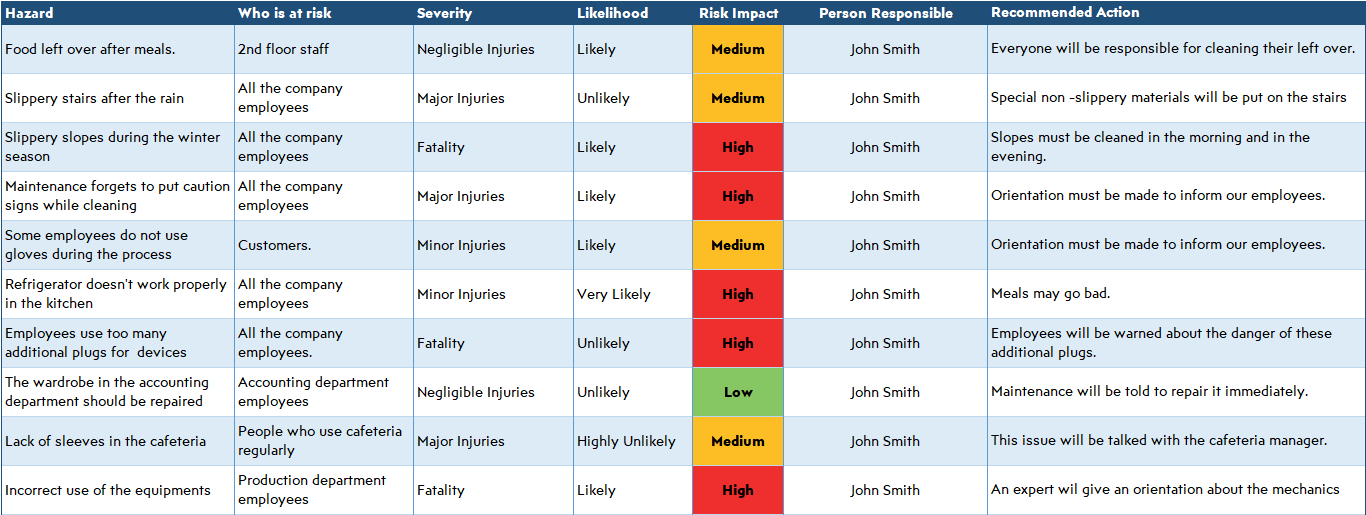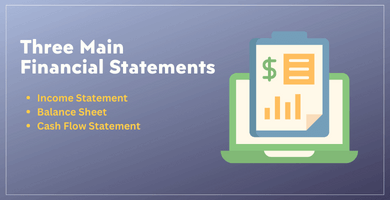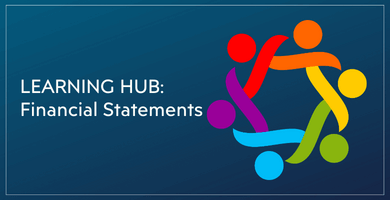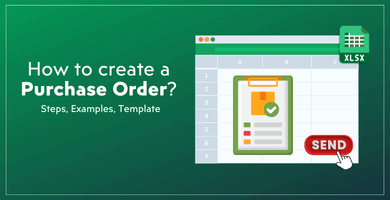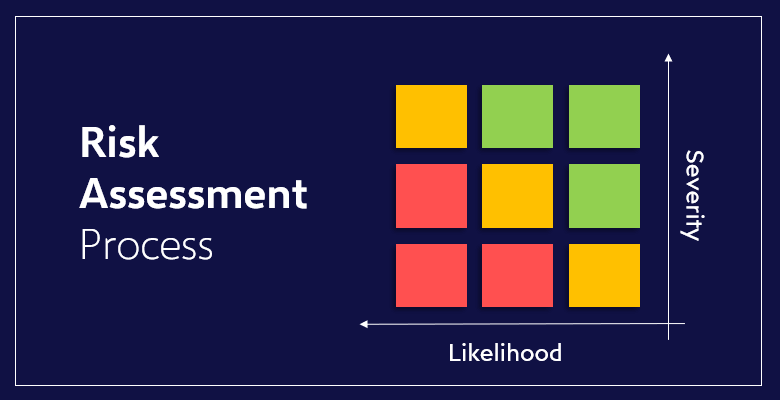
Overview of Risk Assessment Process: Importance, Steps, and Framework
Contents
- What Is Risk Assessment?
- How to Conduct the Risk Assessment Process?
- Why Risk Assessment Is Important for Your Business?
- Quick Example of Risk Assessment Process for restaurants
- How to Write a Risk Assessment Report?
- Someka Risk Assessment Excel Template
- FINAL WORDS
Every company, every large corporation, or even every small business has to take risks in order to profit and succeed in the market. However, if these risks are not evaluated and assessed, the financial affairs of the company can be negatively affected.
For this reason, we want to explore the ‘risk assessment’ term by detailing what it exactly is.
In this blog post, we will talk about how to conduct the risk assessment process in your company as well as digitally in software and why every company should oversee these potential hazards.
1) What Is Risk Assessment?
Simply put, it is a process which you pinpoint all of the potential harms, and hazards that can negatively affect your company. By doing that you can also analyze the identified risks and determine the proper solutions to those.
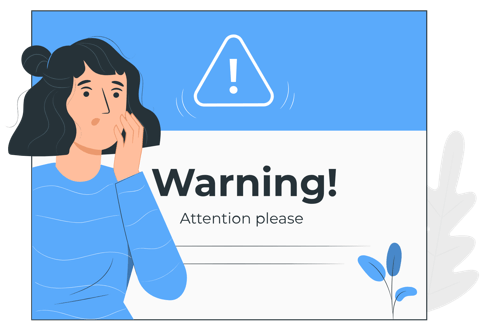
With the risk assessment method, you can conduct an in-depth identification of all the potentially harmful situations and processes that can occur at your workplace and during your work hours.
This is called hazard identification. It allows you to find all the potential hazards, list them one-by-one, and describe the distinctive specifications.
After you made hazard identifications, it is time for analysis and evaluation processes.
Risk analysis can provide the necessary information for you to successfully conduct the assessment process in general. This information can include:
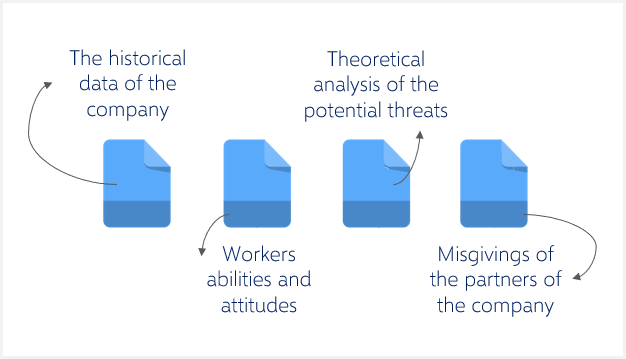
In the analysis and evaluation steps, estimating the risks and comparing them depending on their likelihood to occur are crucial actions.
Only then, the criteria and the significance of the hazards can be established and determined.
When the significance and the likelihood of the hazards are determined, the next step is decision-making.
You can decide how to effectively eliminate the potential harm that can hurt your company. By monitoring your workplace, re-evaluating your workers, and taking precautions, you can easily implement your decisions.
2) How to Conduct the Risk Assessment Process?
Before starting, the selection of the individuals who will conduct this research and the findings of these individuals is crucial.
Every step of the assessment process should be conducted by a competent person who has sufficient knowledge of the workplace, the workers, and the work done in general.
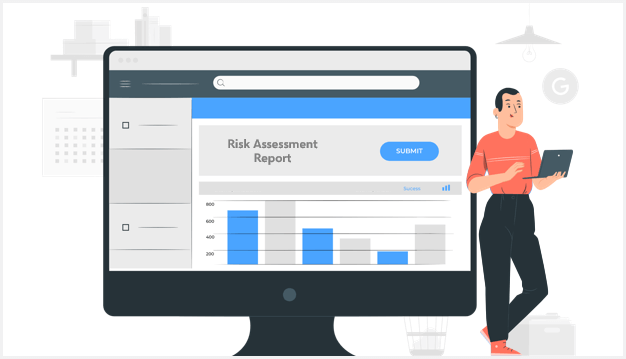
If you are on the risk assessment team, you should consider the following aspects of the process:
First, you have to figure out how big you want the scope of the assessment to be. It is an important detail for you to pinpoint in order to get accurate results.
Recommended Reading: Conducting GAP Analysis: Tips, Tools, and Examples!
Equally important, you need to gather the necessary sources. Combining the sources and the resources which will help you collect the information required to obtain any kind of result is a key activity in the process.

You will be checked by not only your supervisors but also ‘the people at the top’ as well. Therefore, remember that the results you obtain from your assessment have to be acceptable by the shareholders of the company, too.
Lastly and perhaps most importantly, you need to read up on the laws and regulations you have to follow.
Regardless of the significance of the risks, you need to be impartial at every step of the process and you will be able to achieve this by following the laws and regulations.

Identifying the hazards:
The overall goal in this step needs to be finding, recording, and listing the possible hazards which can be present in the workplace.
However, if a hazard is not present in the time being, it doesn’t mean that it is not going to exist in the future. So, it is crucial to consider any potentially negative situations along with the current state of the workplace.
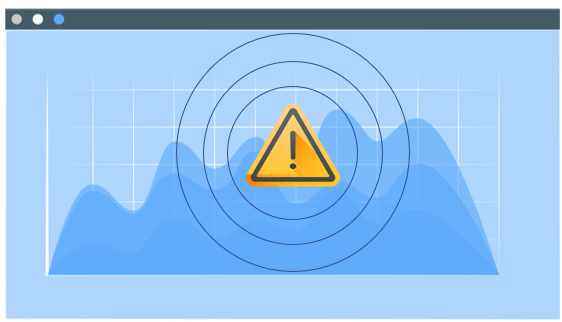
Forming your team by combining people familiar with the work area and individuals who can bring a fresh eye to the inspection can be helpful in the process.
The identifying process should include inspecting every aspect of the work; this consists of routine, everyday activities as well as non-daily routines. Also, the team in charge of this step of the process should obtain past records regarding accidents, incidents, and controversial situations.
The risks to the public should also be examined.
We can give museums for an example! The safety of the large collection of items in a museum should be considered and assessed in the report. Otherwise, the visitors entering and exiting the museum and viewing the historical items can be in danger.
Analyzing who might be harmed:
In this step, you analyze the dangerous situations by figuring out how every hazard can cause harm. Also, different hazards can affect different employees.
For this reason, keep in mind to ask the question:
“Who can get hurt?”
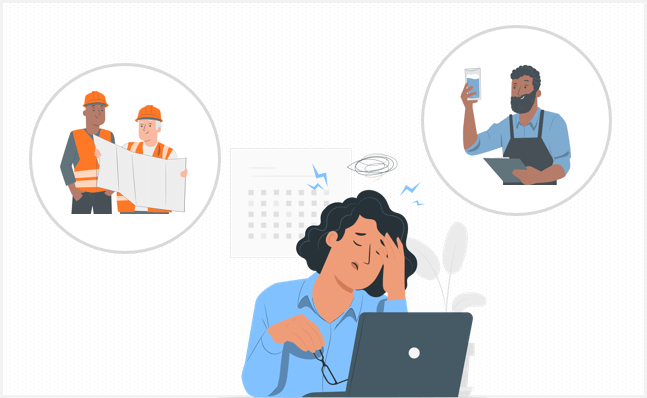
- Uninformed and inexperienced workers can hurt themselves while using the machine and can cause harm to others (and possibly to the public).
- Any old or expired product or any machinery without a warranty can create danger and potentially considered a hazard.
- Every health and safety material should be present and remain in reachable places. Employees who are responsible for the conduct of these materials read upon health and safety guides.
The application of the guides is also important. You should apply and check the industry codes of practices on every activity which can cause danger and might be harmful.
Any injury, accident, or illness related to work or happened in the workplace must be researched, recorded, and listed.

Evaluating the risks and prioritizing them:
After you analyzed and detailed who might be affected by them, it is time for you to consider the likelihood of the potential hazards and the severity of the consequences of those risks.
This evaluation will help you in the process in terms of the listing, categorizing, and most importantly prioritizing your list of potential threats.
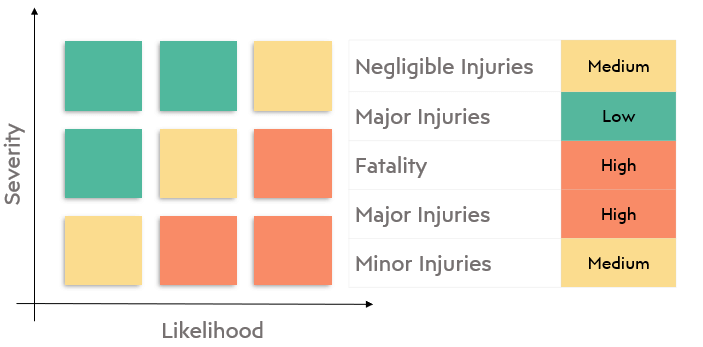
Ranking individual hazards is one of the ways to determine which risk to consider or control first.
By prioritizing the risks you found, you would be establishing a so-called ‘plan’ in order to respectively tackle them on the report and individually eliminate or control them. Thus, you would create an ‘action list’.

Recommending actions and eliminations:
You detected the risks, analyzed, evaluated, and ranked them; however, they cannot remain just as risks. Necessary actions must be taken to eliminate them.
For the company to control and get rid of these hazards, your team should provide and recommend actions. In general, the company utilizes methods such as:

3) Why Risk Assessment Is Important for Your Business?
Risks are no jokes. The reason why they are risks is that they are harming, hurting, and damaging human lives.
Potential hazards, if not treated, can cause immense damage not only to the financial affairs of the company but also to every employee, employer, chief, director, shareholder, or even CEO of the company.
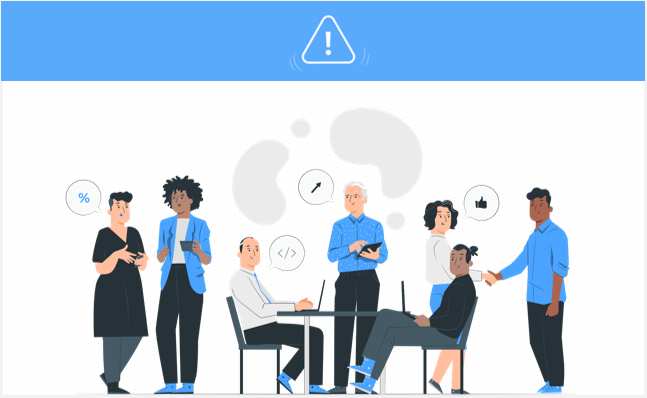
Therefore, risk assessment is not only a crucial part of the organization but also an irreplaceable part of the occupational health and safety management plan as well.
Free Downloadable Resource: COVID-19 Employee Health Tracker Excel Template
These risks can result in:
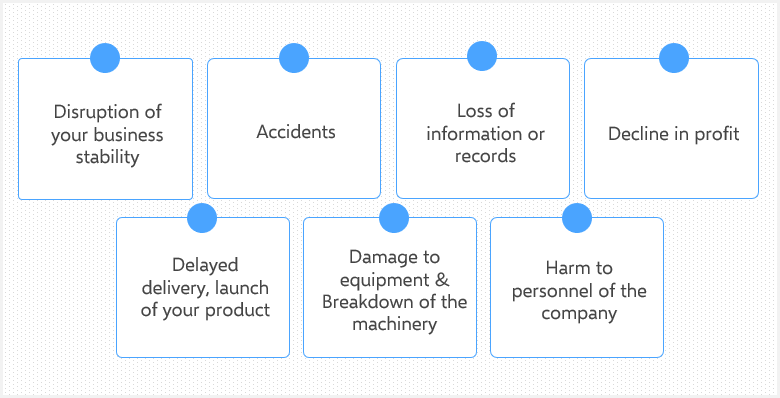
You and your company would be risking a lot of necessary and important aspects of the business. Now, let’s look at what you would gain from conducting risk assessments. These are the benefits.
- Identification of any risks that can harm the public
- Control of the company weaknesses
- Prevention of injuries and illnesses
- Recognition of the company assets and valuables
- Management of every financial, physical, and critical risk
- Awareness of threats, hazards, and harms regarding your company
4) Quick Example of Risk Assessment Process for restaurants:
In this chapter, we would like to present an example of a risk assessment report while showing you the specific aspects.
Now, imagine you are in charge of a restaurant.
Being the manager, you have to take care of the customers. Satisfy them with the food and make their experience an enjoyable one.
The risk assessment team identified and evaluated all the problems in the restaurant. One of the hazards they found was that some employees were not wearing any gloves. These can create huge risks if the employees are the cooks in the kitchen.
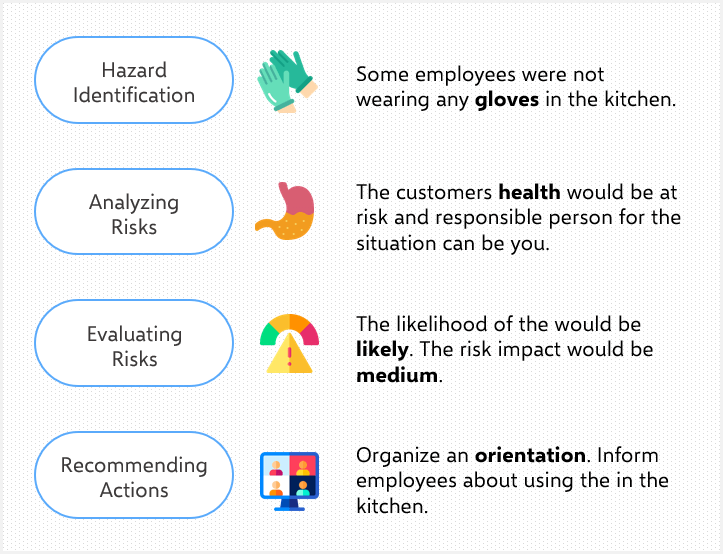
Make Restaurant Feasibility Study in Excel!
5) How to Write a Risk Assessment Report?
As with every report, you can create your risk assessment report simply with a pen and paper.
However, identifying and detecting the hazards, deciding on the severity of the danger, and recommending action and on top of that, writing every little detail down on a piece of paper by hand is hard work.
So, in brief, the pen & paper method is a ‘thing of the past’. It is time-consuming, tiring, and complicated to organize.
Tools for Risk Assessment:
Integrum: One of the programs you can use to create your report is Integrum. This is one of the most comprehensive tools in the market which is designed to optimize your business performance.
It makes identification very complete with a proper reporting system. So that you can create many dashboards, reports, and graphical analysis.
Cura: CURA is a web-based risk management solution that provides flexible identification and monitoring. Visual dashboards, surveys, a self-assessment portal, notifications, workflow management designed to help you understand the impact that your company encounters.
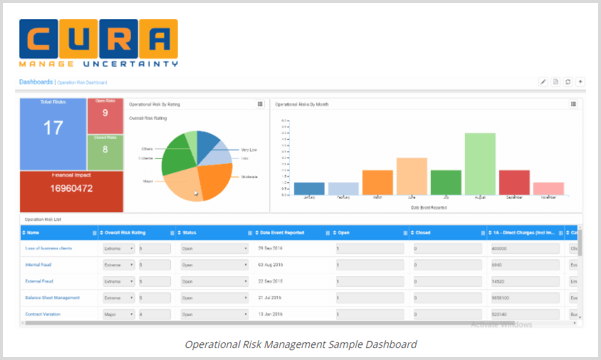
Word: The other software you can use is Microsoft Word. It is the simplest option compared to the other programs. You could create tables, write the data in, and print it; however, Microsoft Word is not built for the process of creating a report.
You would be responsible for every letter of the data you enter and every table would be up to you to create and fill in. We have an option better than that.
Microsoft Excel is another great solution in order to create your risk assessment report. All of us have to be working at all times to achieve what we desire in today’s world.
That’s why time is crucial and by using Excel you would be saving time. Because Excel is a software which we are all familiar with and we do not have to learn it from scratch.
Our Risk Assessment Excel Template is designed to help you manage and control all the potential hazards that your company may have. There is no learning curve. You will be confident that if you use our template in Excel while creating your report.
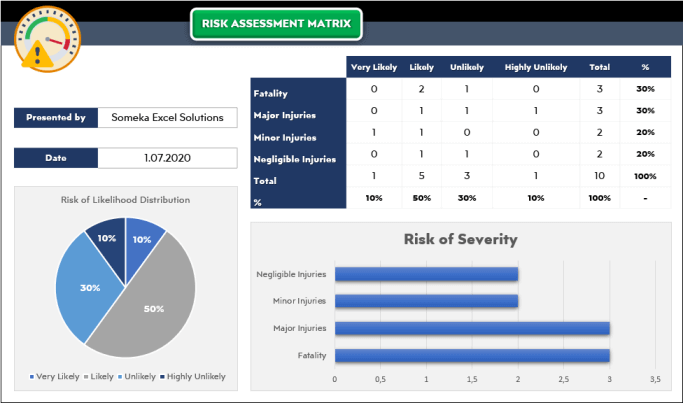
Your tables for the report are already created and ready for you to fill in your data. It is designed not only with an easy to use a text-based design but also including a visual dashboard view for you.
The best part? It is free to use!
Be One Step Ahead by using Risk Assessment Excel Template:
Unlike other software packages and programs, Risk Assessment Excel Template provides two beneficial features: Dashboard and the Risk Assessment Matrix.
Dashboard tool lists the hazards which might cause harmful situations and can easily analyze them regarding their severity and likelihood. Also, it can present your data with easy to understand and high-quality graphics.
After you put the data and the information for the Hazard’, Who is at risk, Person Responsible and Recommended Action in the columns, by only selecting the ‘Severity’ of the risk, you would get the result of the ‘Risk Impact’.
Risk Assessment Matrix calculates the impact of the hazard you put in.
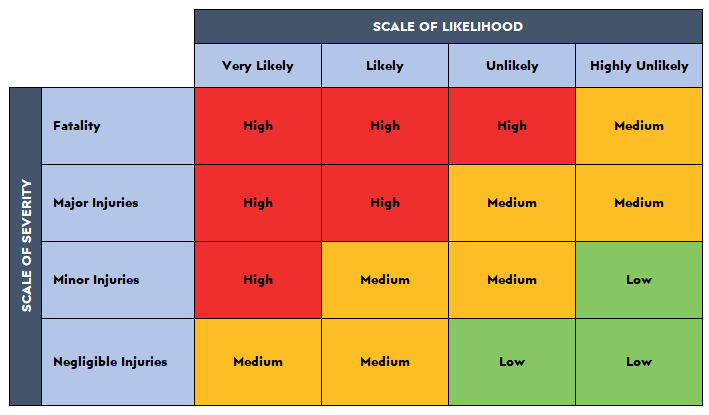
You can clearly see the Scale of Likelihood and the Scale of Severity and how it is calculated. However, you want to change these scales in order to make them the same as your company’s procedures and policies.
It is hard and time-consuming in which you have to change all of the data and information you put in before, right?
Because it is designed so that you can change the scales and modify the text without worrying about the other information you put in. You can change data and once you do that everything in the Dashboard will be updated accordingly. Moreover, every Windows computer has Microsoft Excel in it, so there is no need to install anything into your computer:
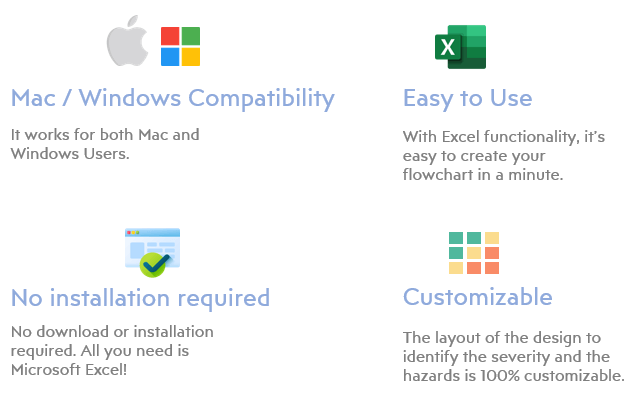
With these many uses and features, it can come across as an expensive Excel template. However, compared to the other programs and software packages, this ready-made template is the most affordable one which includes various useful specifications.
Further, after you are done with your report, only with a click of the button, your report will be print ready and also exported as a PDF file.
Another important framework for risk management is Failure Mode and Affect Analysis (FMEA). With Excel FMEA tools you can identify potential failure modes with causes and actions. If you want to use this tool smultaneously with your collegues, you can try FMEA Google Sheets Template. Both are designed especially for process risk analysis.
Another data visualization tool for risk assessment is bowtie diagrams. Someka has now a Bowtie Diagram Excel Template, which lets you to show your risk pathways in a cause and consequences model. You’ll see all your risks and hazards in a bowtie chart.
FINAL WORDS
All of the failures, disasters, injuries, and accidents happening in the workplaces are rooted in not carefully considering and taking into account the hazards of the company. Identification, analysis, and assessment of these situations must be conducted before the occurrence of any of the negative events or situations.
In order to eliminate them and prevent any trouble which can affect your company, employers, and yourself; initiate the risk assessment process with a competent team. You can also use our ready to use Excel template and its useful features would be by your side while your company undertakes this important task.





